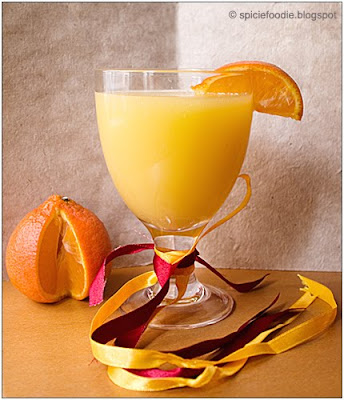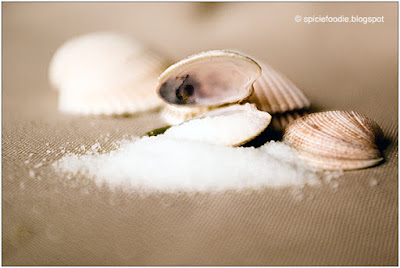
Pumpkins, pumpkins every where I look! Halloween is right around the corner and the American Thanksgiving holiday is also soon to come, and many of us are getting ready for these two holidays by buying pumpkins. You already know what to do with your pumpkin on Halloween, make Jack-o'-lanterns, and Thanksgiving day means pumpkin pie. Many of us have already made pumpkin soups, bread, muffins, pies, all sorts of sweet and savory dishes. But how much pumpkin can you eat in a couple of months before getting pumpkined out? The dilemma - what to do with all the extra pumpkins we bought before we had our fill of pumpkin everything? Pureeing and preserving extra pumpkins is a great way of using up our lovely seasonal friends.

But before I tell you how I do so, another question popped in my head, are all pumpkins edible? Apparently, yes they are. Mind you not all pumpkin varieties are equal in taste and texture. If you are unsure of the pumpkin, double check with the produce man to double check the correct pumpkin for your special cooking needs. These two sites are a great source of information on the taste and uses of many pumpkin varieties,
"Pumpkin Nook" and
"All about Pumpkins" .
The word Pumpkin originates from the Greek word pepon, which means large melon. Then the French changed pepon to pompom, which then was changed to pumpion by the British, which then was changed to pumpkin by American colonist. Though much different looking than the popular round species we find today, pumpkins are thought to have originated and first cultivated in the Americas. Native Indians from the America had many uses for pumpkins, using every part from the flowers to the seeds,flesh and shells. Pumpkins were woven into mats, used as a food source, and hollowed out to make bowls to eat off and to use as storage containers. Nowadays pumpkins are grown all over the world with many varieties to choose from.

Pumpkins are not only tasty and versatile in our kitchens, but are also great nutritious food. The bright orange varieties are loaded with beta-carotene and antioxidants. Pumpkins and their seeds are high in fiber, and (the seeds) are a good source of zinc and protein. Whole pumpkins have a high water content making them a low fat and low caloric fruit, (yes they are a fruit not a vegetable).
And now getting on to what to do with all those extra pumpkins. I choose to puree and freeze mine for the coming months. There are several ways to cook the pumpkin before pureeing it. Steaming, in a microwave, boiling, or my preferred method baking. The instructions below have been used on 3 types of pumpkins( sugar pumpkin, jack-o' -lantern, and Musque de Provence - Fairytale pumpkin) all with good results, and all for different recipe uses.

1. Preheat the oven to 200c or 392f . First wash your pumpkin thoroughly, place on a cutting board and carefully cut in half. Next remove the stringy center , set the seeds aside if you want to roast them, discard the stem. You can either leave the pumpkin in 2 halves or cut into smaller slices. Place the pumpkin halves/slices in a large baking dish. If you are just using 2 halve place them with the outer shell facing up, otherwise place slices on their sides.
2. Bake until the pumpkin is soft. Testing the pumpkin with a fork or knife to make sure it has cooked all the way through. If the pumpkin is still hard in the center but if the outer flesh is turning too dark, cover with aluminum foil and continue to cook until soft. Depending on the size and variety of your pumpkin it can take anywhere from 45 minutes to 1 1/2 hours or longer.
3. Once the pumpkin has softened all the way through, let it sit to cool down. (You can also place in the refrigerator to finish the following day.) Once the pumpkin is cooled down, using a spoon begin to scrap the flesh away from the outer shell. Do this over a large bowl or into a blender and throw out the outer shell. When you have finished with the whole pumpkin, put into a blender or with a hand held mixer blend until you have a smooth puree ( about 5 minutes. ) You could also use a potato masher and mash until you have a soft mixture.

If you will be using the pumpkin puree within a couple of days just store in the refrigerator. I will be freezing all my puree. In freezer safe containers or in small plastic bags portion out the amounts of pumpkin puree your recipes typically call for, label and date. I have stored pumpkin puree in the freezer for up to 4-5 months, with no problems. Actually I have found pumpkin puree freezes quite well, with no harm to the taste or texture. So now you can enjoy your favorite pumpkin recipes year round!

And this is all the pumpkin you will have left over!!
Read more...


 *seasoned with salt*
*seasoned with salt* *seasoned with spices*
*seasoned with spices*






 Your Ingredients:
Your Ingredients:






 Malaysian chicken curry puffs a first in my kitchen, and a dish that has become a favorite and one that I will cook frequently . Malaysian cuisine is one that has been on my checklist to learn and cook. I am not really sure why I didn't try it sooner, but thanks to our friend (aka frequent dinner guest :) ) it moved up on my foods to cook very quickly. While on a trip to Malaysia he picked me up a wonderful cook book. It is called "
Malaysian chicken curry puffs a first in my kitchen, and a dish that has become a favorite and one that I will cook frequently . Malaysian cuisine is one that has been on my checklist to learn and cook. I am not really sure why I didn't try it sooner, but thanks to our friend (aka frequent dinner guest :) ) it moved up on my foods to cook very quickly. While on a trip to Malaysia he picked me up a wonderful cook book. It is called "
 **Notes,I used commercially prepared pastry dough and baked the pastries instead of frying, this worked just fine. The pastries were flaky and absolutely delicious! I also made only half a recipe and cut the pastry into a bit bigger circles to serve as a main dish for dinner.
**Notes,I used commercially prepared pastry dough and baked the pastries instead of frying, this worked just fine. The pastries were flaky and absolutely delicious! I also made only half a recipe and cut the pastry into a bit bigger circles to serve as a main dish for dinner.






